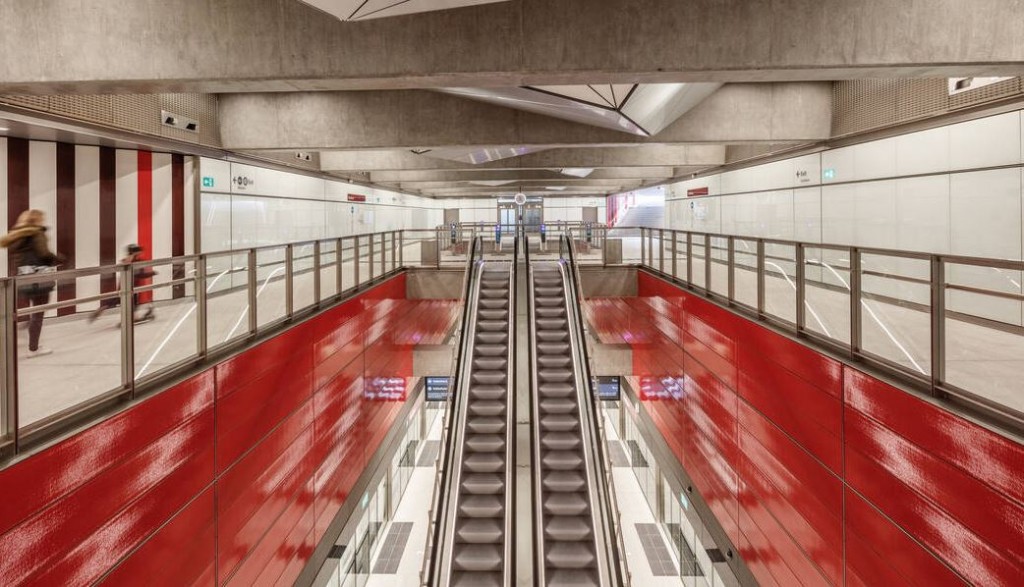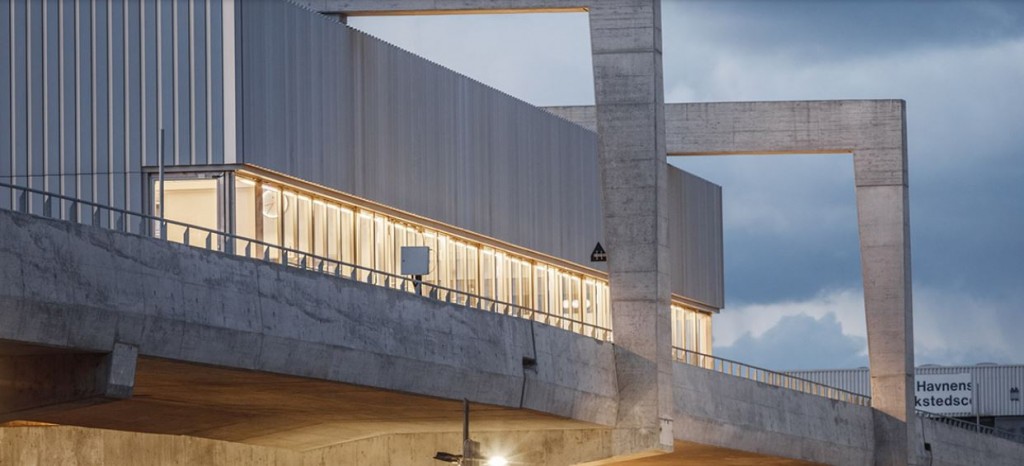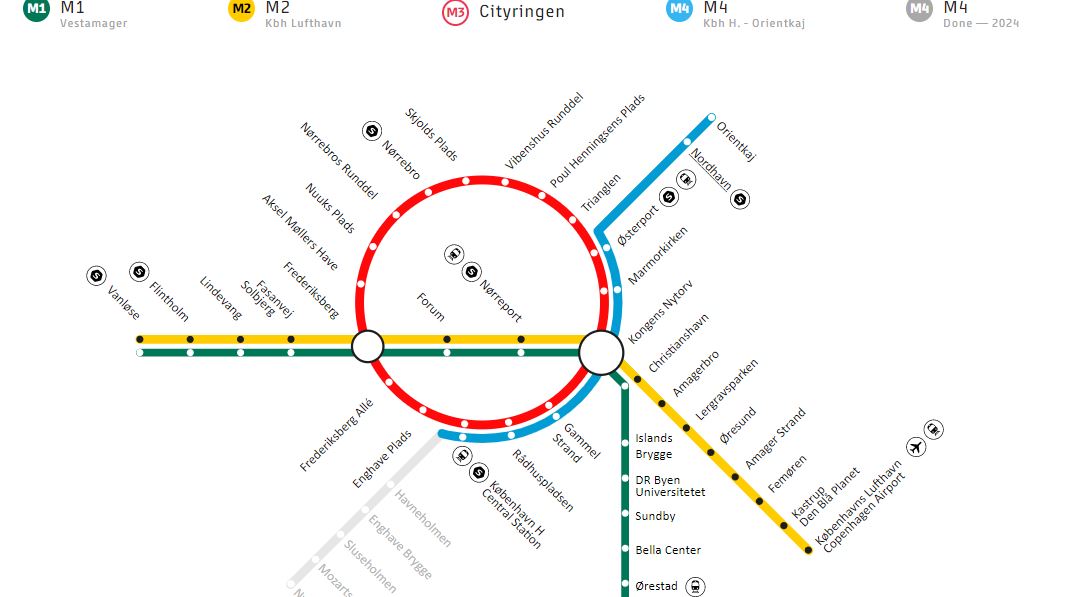
New Orientkaj metro station in Nordhavn’s historic docklands area. Revitalized Nordhavn has become a hot destination for new architecture, furniture showrooms, design studios, boutique hotels and new dining venues. (photo © Rasmus Hjortshøj – COAST)
by Ron Bernthal
From savvy new architecture and design galleries to seaside bathing and amazing dining venues, Nordhavn is a revitalized Danish city located on the Øresund strait, just 10-15 minutes from Copenhagen’s center city via the new M4 Metro line.
Danish architecture studio Cobe, in collaboration with the London-based engineering firm Arup, have designed the newly opened elevated Orientkaj Metro station, and the underground Nordhavn Metro stations, both of which opened in March, 2020, as part of the revitalization of Copenhagen’s northern docklands area. One of the main projects of the regeneration is the Nordhavn extension of Copenhagen’s M4 metro line, a dual- track line branching off from the City Circle Line M3 metro, which opened in 2019.
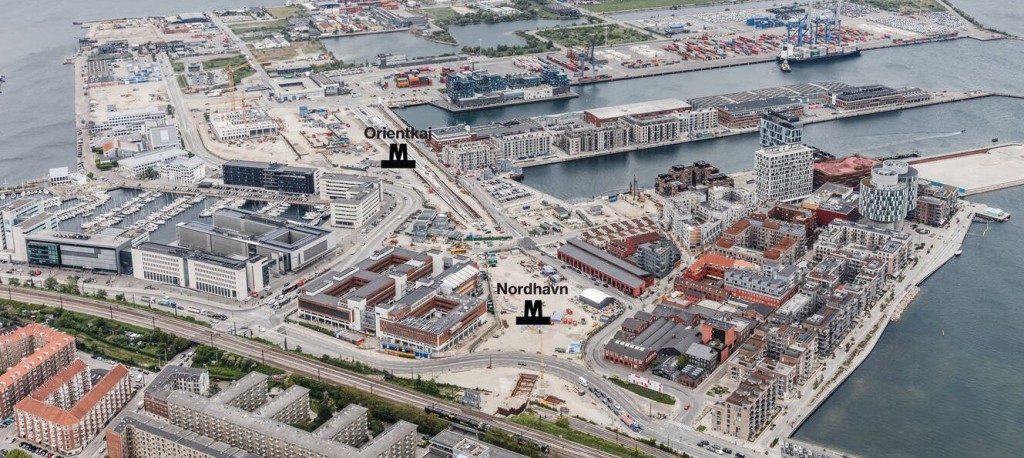
Nordhavn aerial view showing two new metro stations and surrounding terrain (photo Rasmus Hjortshoj – COAST)
The two new metro stations are part of the redevelopment of a large area of the historic docklands, located on the north side of Copenhagen, that will eventually create 16 million square-feet of sustainable mixed-use buildings, 40,000 residential units, office space for 40,000 people, and plenty of new retail and culinary venues, all part of an urban master plan designed by Cobe. The redevelopment of Copenhagen’s northern suburb of Nordhavn, including the new public transport link, is one of the largest urban regeneration projects in northern Europe.
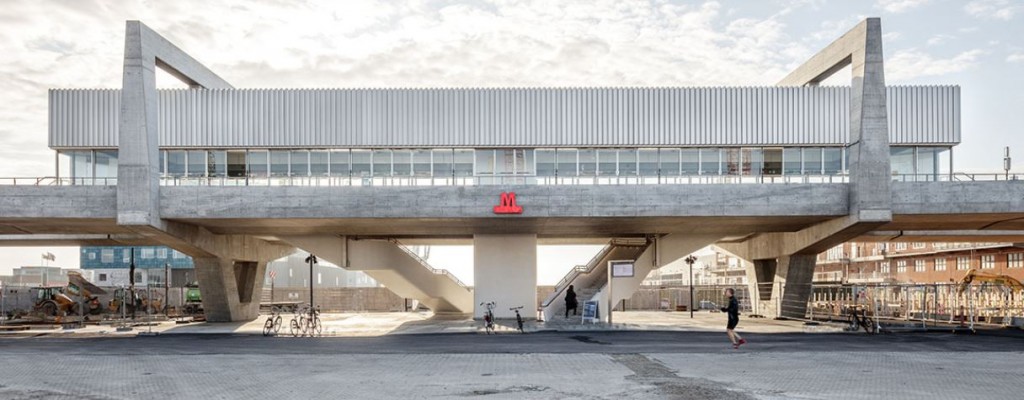
Orientkaj Metro station. Views from the station platform were a key design consideration. On a clear day passengers can look across the Øresund into Sweden (photo credit Rasmus Hjortshoj – COAST)
The two stations possess distinct visual characteristics that reflect the local communities they serve. Using the outline of a shipping container, the overground Orientkaj Station celebrates the large scale and brutalist architectural features of the dockland’s industrial past, but reveals a more gentle, human-focused detailing in the station’s interior. The station is designed as a glass, concrete and aluminium box commandeering panoramic views over the Orientkaj docks and the Øresund, the body of water separating Sweden and Denmark. The new underground Nordhavn Station nearby uses a theme from the M3 line station design, the distinctive red colors of the M3 line transfer stations.
The new Line 4 metro extension runs between Copenhagen’s Central Station to Nordhavn Station (8 minutes) and Orientkaj Station (13 minutes), with trains at 10-minute intervals. Both stations are expecting about 9,000 daily users by 2025, as Nordhavn increases its residential and working commuter population.
From a harbor area with free port status in the late 1800′s to a 21st-century city with vibrant and colorful new neighborhoods, Nordhavn is one of Denmark’s fastest growing areas. Nordhavn (The North Harbor) is located on the Øresund coast, just 3-4 miles from the Copenhagen’s city centre, and offers direct access to the sea, as well as a multitude of recreational urban spaces, new design attractions, boutique hotels and new cafes.
“Nordhavn is an area of sustainable mobility, where it is easier to walk, bike or use public transport, than it is to drive your own car. The two metro stations unlock the potential of this new Copenhagen city district enabling more efficient and sustainable transport between the individual neighbourhoods, and to the rest of Copenhagen, while adding a new chapter to the story of the Copenhagen harbor front,” said Dan Stubbergaard, architect and founder of Copenhagen’s Cobe architectural studio.
Unlike Paris’ 100 year-old Metro, and London’s vast Underground, established in 1863, Copenhagen’s transport network is very much a 21st century, work-in-progress project. First opened in 2002, the last two decades have seen the Copenhagen Metro steadily growing, its linear, driver-less, rapid-transport lines spreading outwards from Copenhagen’s center to the to the city’s vibrant new neighborhoods. For the recently completed Nordhavn metro line extension, connecting the northern docklands to downtown Copenhagen, designers decided against a generic architectural style for the two new stations (Orientkaj and Nordhavn), using a ‘passenger-focused’ approach that celebrates the character and industrial past of the docklands district.
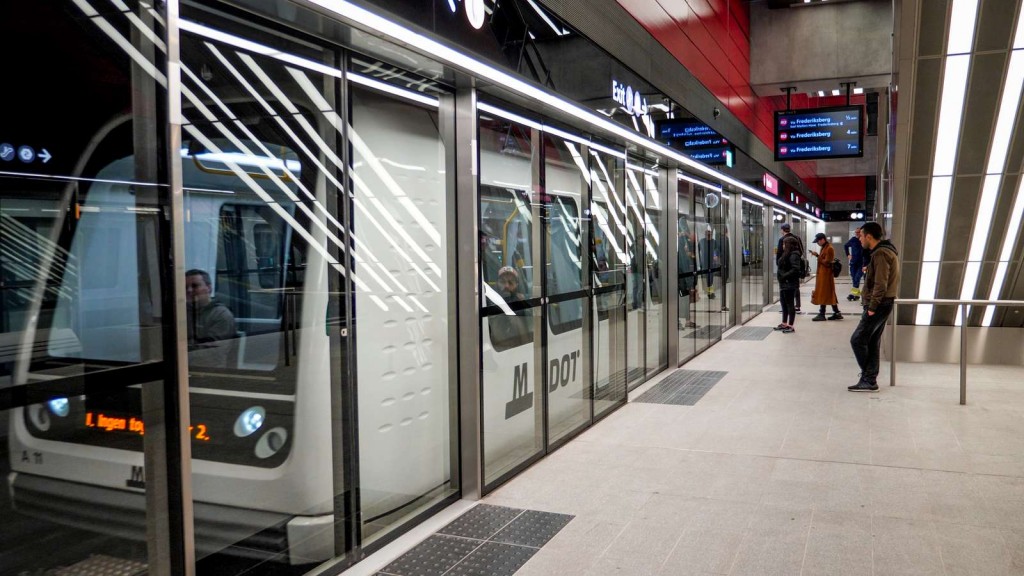
Copenhagen metro, a modern transport system that opened in 2002 (photo Daniel Rasmussen Copenhagen Media Center)
“The design of Orientkaj station provides a great passenger experience for visitors to this growing area of Copenhagen,” said Arup’s lead architect, Kristian Winther. “Anticipating a future high-rise development next to the station, the architects used anodised aluminium panels on all façades to maximise sky reflection, ensuring that the building offers congenial lines of sight from all angles. Views from the station platform were also a key design consideration, the large, glass-plated platform screen doors mean that, on a clear day, passengers can look across the Øresund strait directly into neigbouring Sweden.”
Inside, the vast rectangular hall is column-free, supported by the external concrete frames, skylights representing the shed roofs found in the area’s former industrial buildings, allowing natural light to flood the station during the day. Integrated lighting fixtures provide a pleasant glow at night. The scale of the brutalist, concrete exterior is juxtaposed with polished detailing inside, adding a practical material to the station, while white, hexagonal mosaic covers the stairs and lift towers, with corners rounded for a softer, more human-friendly finish.
Development work in Nordhavn began in 2009 and for a time the area was little more than a construction site, but historic buildings like The Silo, Kanonhuset, Havnehuset and Frihavnstårnet now house residents, while businesses occupy dynamic structures like Portland Towers, office buildings converted from twin cement silos.
The Silo was a former grain silo transformed into a 107,000 square-foot residential complex with public facilities. The 17-storey building, opened in 2017, is a natural point of orientation in Nordhavn. The Silo has 39 unique apartments and the top and lower levels provide public access space.The “glass box” on top of the building is designed as a public restaurant and viewing platform. The glass façade mirrors the surroundings during the daytime, almost vanishing into the sky.
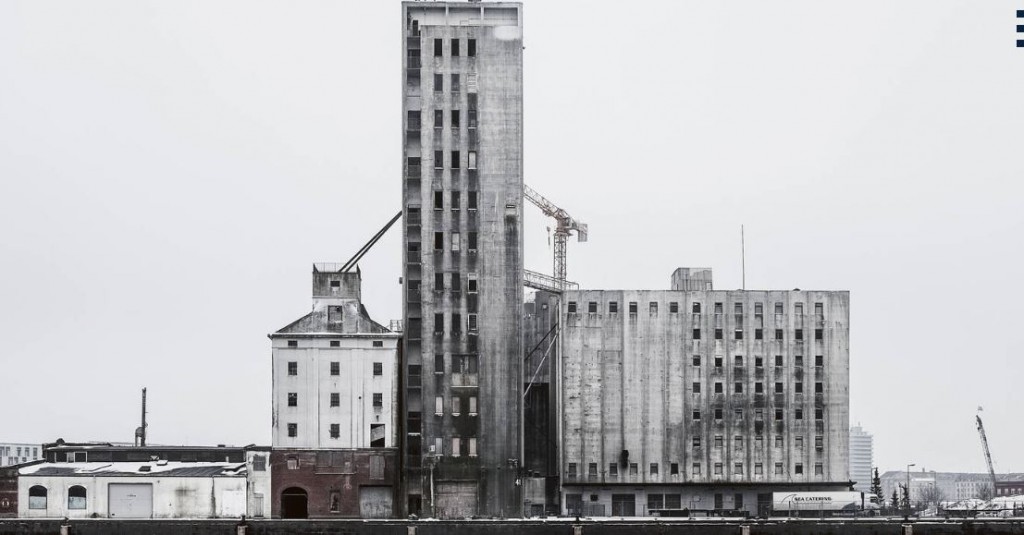
Historic grain silo before conversion into The Silo residential tower (photo below) in Nordhavn. Project conversion design by Cobe architects.

The Silo residential building in Nordhavn after conversion from historic grain silo in 2017. Design by Cobe. (photo Rasmus Hjortshoj – COAST)
Redeveloped warehouses and shimmering new buildings in Nordhavn blend styles, sizes and heights on fragmented, small-scale plots. The new school building project for the Copenhagen International School was designed by C.F. Møller Architects to link the school premises with the public sphere in the urban environment.
All this is criss-crossed by new canals showing Nordhavn’s special connection to the water as well as a planned marina. The area also offers excellent eco-credentials. Buildings and the area’s energy supply are environmentally friendly. Greenery is used creatively, with residential roofs carpeted with plants, and even a modern, outdoor recreational facility on the roof of the Konditaget Lüders parking garage.
A ‘five-minute city’ of small hops between housing, work, day care, transport, recreation and shopping amenities, Nordhavn’s ongoing revitalization encourages walking, biking and using public transport, all part of the Danish lifestyle. Soon, a ‘super bikeway’ will be opened from Nordhavn to downtown Copenhagen, allowing bikers to ride on a smooth bike path largely uninterrupted by streetlights and automobile intersections.

UN City complex (left) and Portland Towers (right) in Nordhavn_photo Daniel Rasmussen Copenhagen Media Center
In Sundmolen, another revitalized neighborhood within Nordhavn, several design studios have opened new offices there, including Cobe, Vilhelm Lauritzen, Gottlieb Paludan, and the Lendager Group. The noted Bjarke Ingels Group (BIG) will soon join them.
The new school building for the Copenhagen International School, designed by C.F. Møller Architects, links the school premises with the public sphere in the urban environment. The new school building (see below) has 12,000 solar panels, each individually angled to create a sequin-like effect, which will supply more than half of the school’s annual electricity consumption. The solar cells cover a total area of 65,000 square-feet, making it one of the largest building-integrated solar power plants in Denmark.

Nordhavn’s new building for the Copenhagen International School designed by C.F. Møller Architects (photo Adam Møerk)
Where to stay when visiting? The Danish design brand MENU has moved its headquarters to the Århusgade district of Nordhavn, where visitors have an opportunity to stay at a boutique hotel that is actually part of Menu’s new headquarters, a hybrid concept called The Audo.
Teaming up with Copenhagen’s Norm Architects, a restored 1918 building consisting of a boathouse and a Neo-Baroque residence, opened in spring, 2019, with a beautiful, minimalistic makeover. The designers developed special concrete flooring and walls, and used warming brass accents to lift the industrial architecture. Within the same building, there are now offices, a cafe, co-working spaces, a concept store and a hotel. Located on the top floor, The Audo Residence is a 10-room boutique hotel that offers understated and intimate loft-style guest rooms. The entire building offers stunning interiors filled with artwork, and public performance spaces are used for lectures, meetings and design and fashion shows.

